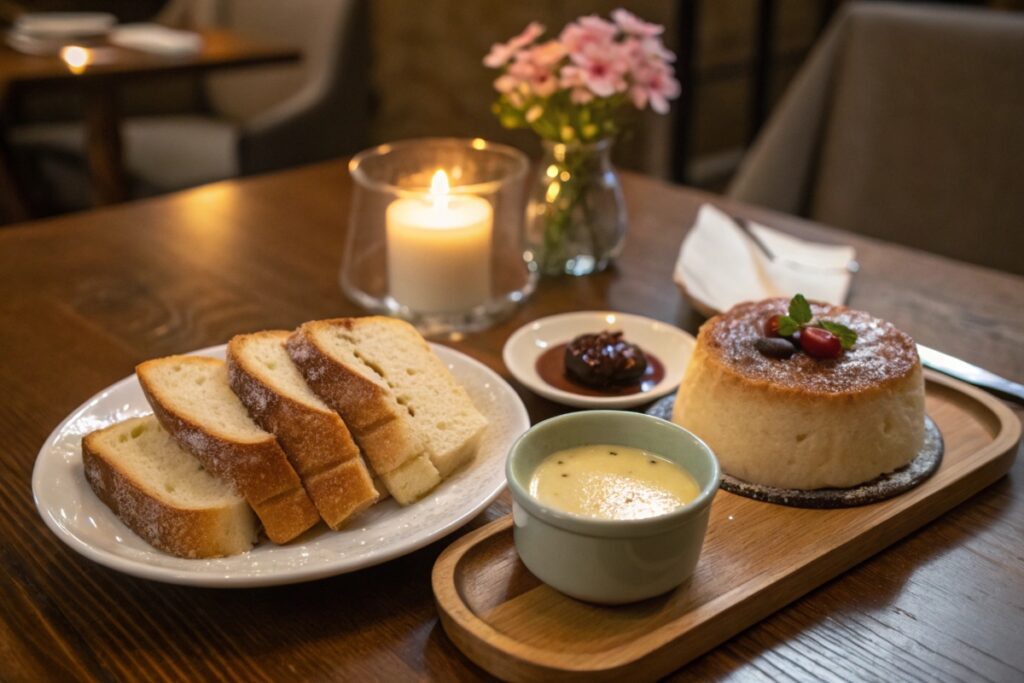Introduction
Milk may not be the first ingredient that comes to mind when you think of Japanese cuisine, yet japanese foods that use milk play a surprisingly significant role. From the rich dairy farms of Hokkaido to the fluffy Shokupan bread on breakfast tables, milk is woven into various dishes that merge tradition with modern tastes. In fact, the popularity of Hokkaido milk has skyrocketed internationally due to its creaminess and subtle sweetness—a far cry from generic varieties found elsewhere.
What makes Japanese dairy so special? It’s a combination of precise farming methods, unique cow breeds, and a deep cultural respect for quality ingredients. Whether you’re preparing a comforting bowl of milky ramen or baking a batch of ultra-soft bread, milk-based products add richness and smoothness hard to replicate using alternatives. Throughout this guide, you’ll discover how milk infiltrates Japan’s culinary scene, from everyday staples to special-occasion treats.
If you’re curious about adding more dairy delights to your repertoire, keep reading. You’ll find everything from bread-based lunch ideas to steamy milk-infused hot pots. For additional Japanese cooking inspiration, discover easy Japanese recipes to pair with your new knowledge of milk-infused dishes.
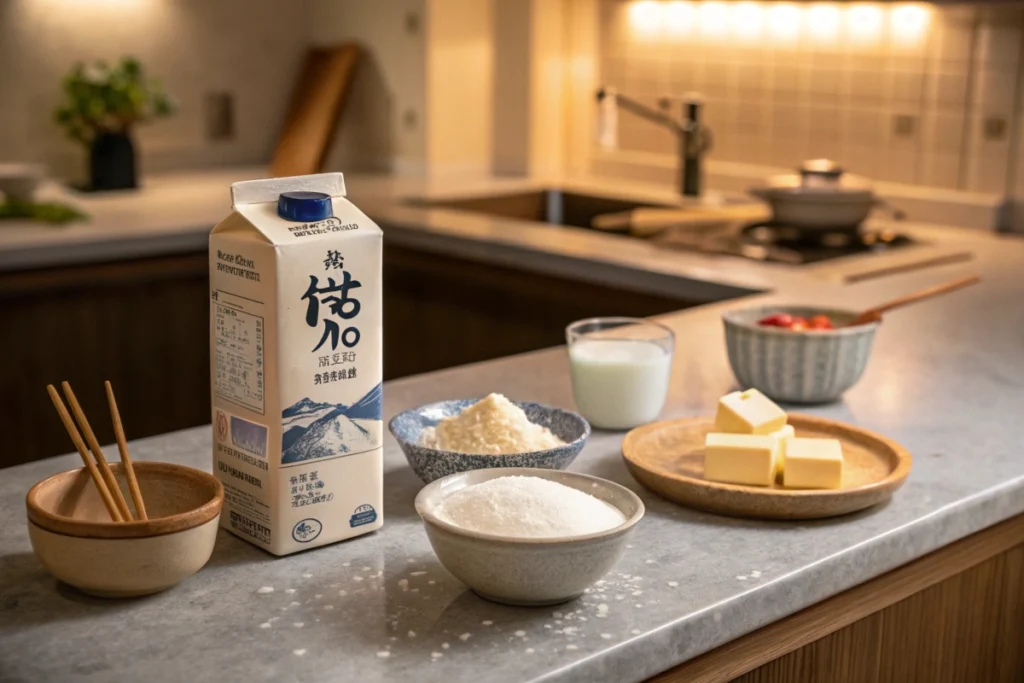
1. Hokkaido Milk: The Crown Jewel of Japanese Dairy
When people discuss japanese foods that use milk, Hokkaido milk is often the star of the conversation. Known for its high butterfat content and velvety texture, this dairy product hails from Japan’s northernmost island, Hokkaido. The region’s cold climate, abundant pastures, and strict farming standards contribute to a milk that’s rich, creamy, and prized nationwide.
Hokkaido Milk vs. Normal Milk
Many wonder how Hokkaido milk stacks up against more familiar varieties. Thanks to fertile volcanic soil and crisp air, the cows in Hokkaido graze on nutritious grass year-round. This diet translates into milk with a creamier taste and slightly higher fat percentage. Comparatively, standard milk may have a lighter body and less pronounced sweetness.
Farming and Processing
Local farmers in Hokkaido emphasize animal welfare, believing contented cows produce superior milk. These cows often roam spacious fields, a rarity in Japan’s densely populated landscape. Additionally, the milking and pasteurization processes are meticulously regulated to maintain freshness and flavor. Some dairies even adopt gentle pasteurization techniques, preserving the milk’s natural aroma.
Culinary Uses
Hokkaido milk elevates even the simplest recipes. Think creamy soups, airy desserts, or luxurious baked goods. Pastry chefs commonly prefer Hokkaido milk to give cakes and custards a distinct smoothness. For a home cook, a mere splash can transform an ordinary cup of coffee or hot chocolate into a decadent treat. If you’re feeling adventurous, you can incorporate this milk into mochi dough or homemade ice cream—both benefit from the added creaminess.
Rising Global Interest
In recent years, tourists visiting Hokkaido often rave about local soft-serve ice cream and cheese-based delicacies. International fans can sometimes find imported cartons in Asian grocery stores. Though a bit pricier, many believe the taste justifies the cost. If you’re craving more indulgent desserts, try advanced Japanese dessert techniques that highlight Hokkaido milk.
Conclusion
Thanks to environmental advantages and careful production, Hokkaido milk has become synonymous with premium dairy in Japan. Whether sipped plain or whisked into a recipe, this silky liquid adds a luxurious dimension to Japanese foods that use milk. Next time you see a label boasting “Hokkaido milk,” you’ll understand why it’s so special—and why food enthusiasts worldwide are taking note.
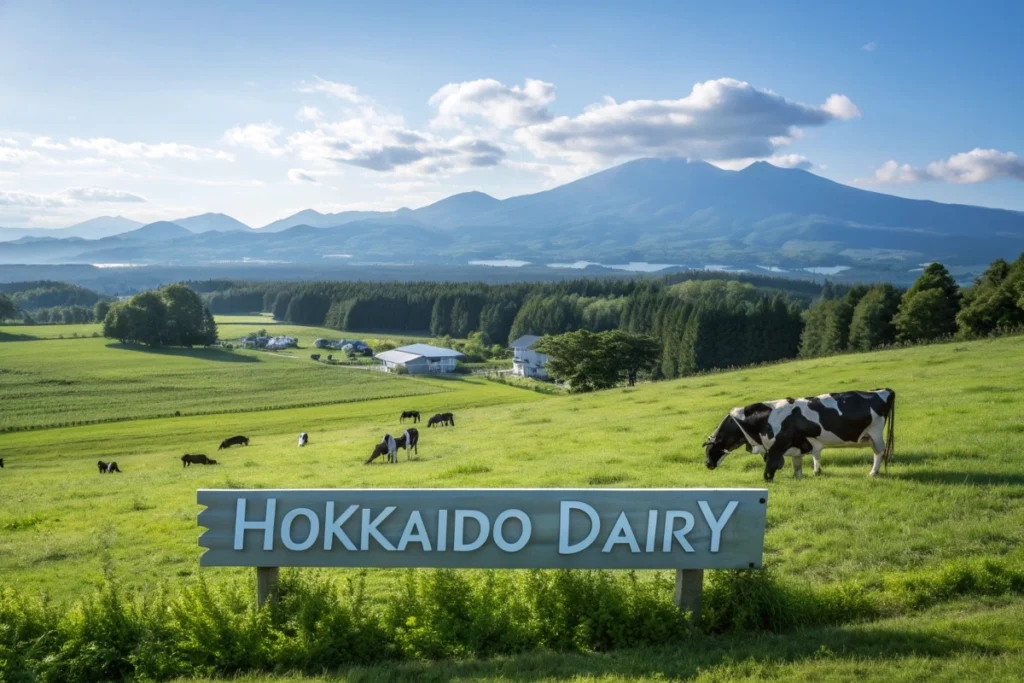
2. Japanese Milk Bread (Shokupan) & Other Dairy-Based Breads
One of the most popular japanese foods that use milk is Shokupan, often called Japanese milk bread. Renowned for its plush, cloud-like texture, Shokupan has become a staple in Japanese households—appearing in everything from breakfast toast to crustless sandwich lunches.
The Magic of Shokupan
Shokupan stands apart from other white breads due to its unique “yudane” or “tangzhong” method. In many recipes, a milk-and-flour paste is cooked briefly, then cooled before being added to the dough. This technique helps lock in moisture, ensuring a tender crumb and elongated freshness. The dough typically includes sugar, butter, and of course, milk—whether standard or Hokkaido—resulting in a subtle sweetness.
Sandwich Ideas & Lunch Innovations
Shokupan’s pillowy structure is perfect for delicate sandwiches. Japanese lunch boxes commonly feature thin slices loaded with eggs, cucumbers, or tonkatsu (fried pork cutlet). Because the bread is so soft, it doesn’t overshadow the fillings, making each bite a harmonious blend of flavors. You can also explore Japanese style white bread ideas, like fruit sando (whipped cream and sliced fruit) for a sweet twist on midday meals.
Beyond Shokupan: Other Dairy-Enhanced Breads
- Milk Buns: Smaller, often individually portioned rolls with a milky taste.
- Melonpan: A sweet bun topped with a crunchy cookie crust, occasionally enriched with milk powder.
- Cream Pan: A bun filled with custard cream, highlighting the synergy of eggs, sugar, and milk in one scrumptious bite.
For those curious about combining bread with alternative dough recipes, explore how to craft Japanese bagel dough for a fun, chewy variation. While not purely a milk bread, these bagels can also incorporate milk for extra tenderness.
Milk Bread Trends
In recent years, artisanal bakeries in Japan have amped up the milk content in their loaves, branding them as “premium” or “extra rich.” Some shops even create special versions featuring swirl patterns of chocolate or matcha. Such loaves can fetch higher prices, yet loyal customers line up for a taste of their heavenly softness.
Making Milk Bread at Home
You don’t need advanced baking skills to recreate Japanese milk bread. Simple recipes instruct you to bloom yeast, combine it with sugar and flour, then incorporate a milk-based paste or tangzhong. Kneading is crucial for gluten development, ensuring the final loaf rises tall. After a couple of proofs, a short bake yields a golden-brown crust and marshmallow-like interior.
Shokupan and other dairy-based loaves prove that milk doesn’t just appear in drinks and desserts—it’s a foundation for everyday enjoyment in Japanese cuisine. Whether you slice it for breakfast toast or shape it into rolls for lunch, milk bread elevates simple carbs into a melt-in-your-mouth sensation.
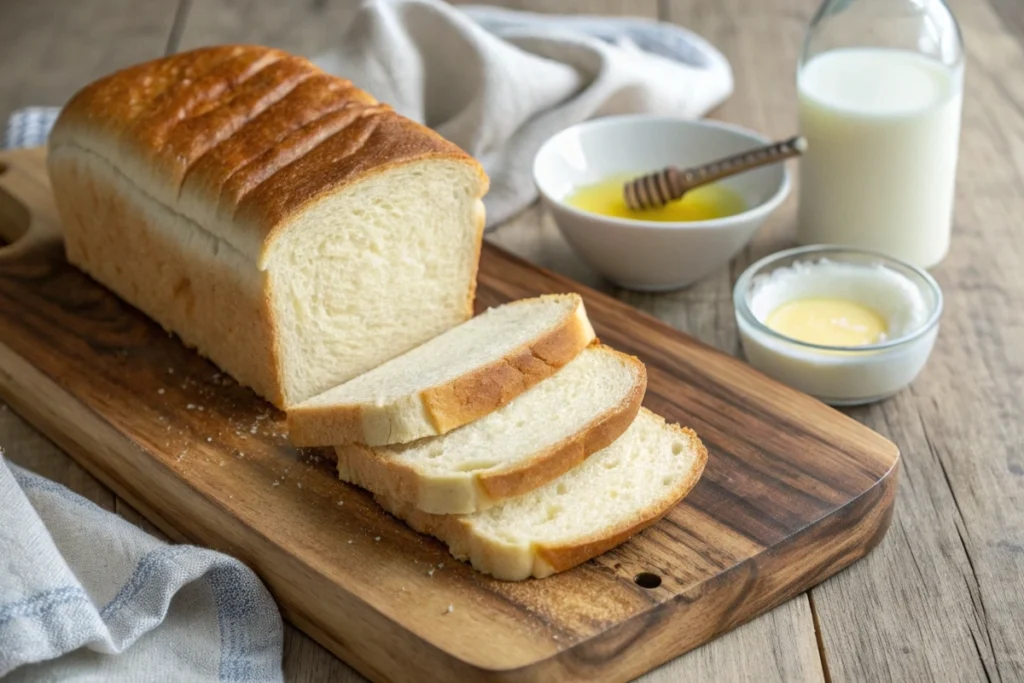
3. Milk-Infused Savory Dishes
Although sweet treats and breads often come to mind when thinking of japanese foods that use milk, savory dishes also showcase dairy elements. From cream-laden soups to subtly milky curries, these recipes reflect Japan’s evolving palate, where Western influence meets local tradition.
Creamy Curries and Chowders
Japanese curry is traditionally thickened with roux, but some variations now blend in milk for a smoother consistency. The addition tempers spice, resulting in a milder flavor profile that kids or spice-sensitive diners appreciate. Similarly, seafood chowders may incorporate cream or whole milk to accentuate the sweetness of scallops, clams, or salmon.
Milky Ramen Broth
While tonkotsu ramen uses pork bones for creaminess, certain ramen shops experiment with adding milk or fresh cream. A small amount can produce a luscious broth without overpowering the dish’s umami. You might also encounter shio or shoyu ramen topped with a swirl of cream—a novelty that pairs nicely with seafood-based broths.
Hot Pots (Nabe) with a Milky Twist
Some hot pot recipes call for adding milk near the end of cooking to round out the flavors, especially if the base is miso or spicy. The result is a mellow, well-rounded soup in which vegetables and proteins simmer. It’s an excellent wintertime comfort meal. To complement your milky hot pot, consider a fresh veggie side like a Japanese radish recipe to keep the meal balanced and vibrant.
Subtlety in Flavor
Unlike Western dishes that might rely heavily on cream sauces, Japanese savory meals often use dairy more sparingly. The goal is to enhance, not dominate. This approach respects the delicacy of underlying flavors—seafood, vegetables, miso, or soy sauce—while infusing a silky finish that only milk can provide.
Conclusion
Expanding your repertoire to include milk-based savory foods can add depth and surprising creaminess to your Japanese cooking. Whether it’s a quick curry laced with dairy or a miso hot pot enriched with cream, these dishes highlight Japan’s openness to culinary influence while retaining a distinct local flair. Next time you crave a comforting bowl of soup or stew, consider this playful twist—milk might just be the missing ingredient.
4. Delightful Dairy Desserts: Puddings, Custards, and Beyond
Desserts often steal the spotlight when we talk about japanese foods that use milk. From fluffy cheesecakes to silky purin (pudding), milk plays a crucial role in delivering that melt-in-your-mouth texture Japanese sweets are famous for.
Purin: The Japanese Pudding
A classic example is purin, a custard akin to flan. Made from eggs, sugar, and milk, it boasts a smooth consistency and a light caramel topping. Purin’s gentle sweetness aligns with Japanese taste preferences, focusing on subtlety rather than heavy richness. Some modern recipes incorporate Hokkaido milk or cream for added indulgence, while café versions might offer specialty flavors like matcha or black sesame.
Softer Than Clouds: Cheesecakes and Soufflés
Japanese cheesecakes differ from their Western counterparts in texture and sweetness. Many rely on whipped egg whites and a good amount of milk to achieve a spongy or souffle-like crumb. The result? A lighter mouthfeel that’s almost reminiscent of a foam or meringue. Similarly, soufflé pancakes often feature milk to maintain their airy profile.
Fusion Desserts
Japan’s skillful assimilation of Western patisserie techniques has given rise to an entire category of milk-enhanced sweets. Creamy eclairs, choux creams, and shortcakes rely heavily on whipped cream—made irresistibly fluffy by premium Japanese milk. If you’re seeking more dessert inspiration, the Japan Dairy Association shares insights on best practices for achieving creamy textures.
Mochi and Milk
While mochi is typically rice-based, certain recipes fuse rice flour with milk. The result can be a chewier, more tender dough, especially in frozen mochi ice creams. Such innovations highlight Japan’s drive to reinvent tradition while catering to modern palates.
Takeaway
Milk-based desserts in Japan prove that dairy can be both delicate and luxurious. Whether you’re a flan aficionado or a cheesecake devotee, there’s likely a Japanese variant that showcases milk’s potential in sweet form. Pair one of these treats with a cup of green tea or coffee, and you’ll see firsthand how subtle dairy notes elevate classic desserts. After sampling these creations, you might find yourself rethinking how to use milk in all your sweet confections.
5. Everyday Uses of Milk in Modern Japanese Life
Milk’s influence extends beyond gourmet pastries and specialty breads. Modern Japanese households rely on milk in various ordinary scenarios, illustrating how japanese foods that use milk are now embedded in daily routines.
Breakfast and Beverages
Many Japanese families begin their morning with a glass of milk or café au lait. While matcha and traditional teas remain staples, Western-style coffee culture has flourished, with latte art becoming a common sight in urban cafés. Hokkaido milk’s creaminess is especially prized in lattes, cappuccinos, and milk tea.
School Lunches and Home Cooking
Milk is a standard part of Japanese school lunch programs, ensuring children get sufficient calcium. A small carton is served alongside typical fare, which can range from fish and vegetables to bread and noodle dishes. In home kitchens, cooking classes often teach recipes that incorporate milk or cheese, reflecting growing acceptance of dairy beyond the occasional novelty.
Packaged Foods and Innovations
Japanese supermarkets stock an array of milk-based products, from yogurt drinks to cheese-filled croquettes. Food manufacturers continually experiment with fusions like green tea latte mixes, creamy instant ramen, or mochi-infused snacks. In convenience stores, you’ll find limited-edition items—like a seasonal sweet bread stuffed with milk-based custard—illustrating how swiftly dairy trends evolve.
Health and Nutrition
Consumers wary of high sugar or fat content can opt for low-fat or skim versions of milk. Meanwhile, the “Hokkaido milk” label often connotes higher quality. Some people are drawn to the purported “Hokkaido milk benefits,” such as richer protein profiles and more natural sweetness. Although these claims aren’t always scientifically proven, they reflect widespread belief in the region’s superior dairy.
Wrap-Up
Milk has seamlessly integrated into the Japanese lifestyle, from morning coffee rituals to school lunches and late-night convenience store runs. This widespread acceptance symbolizes a cultural shift that began in the Meiji era and has accelerated in the past few decades. Now that you’ve explored milk’s daily significance in Japan, you might spot new opportunities to incorporate it into your own routine—be it adding Hokkaido milk to your morning brew or experimenting with milky stews for dinner.
History and Context of Japanese Foods That Use Milk
Traditionally, Japanese cuisine leaned heavily on seafood, vegetables, and soy products, with minimal dairy consumption. So how did japanese foods that use milk become so integral? The answer lies in a tapestry of cultural shifts, Western influence, and regional innovation—particularly in Hokkaido.
Early Dietary Preferences
For centuries, milk was not a mainstream component of the Japanese diet. The country’s agrarian focus emphasized rice, soy (tofu, miso), and fish over livestock. Dairy was sometimes viewed as foreign or even distasteful due to unfamiliar aromas. Buddhist dietary practices, which often discouraged animal-derived products, also contributed to a focus on plant-based meals.
Meiji Era Modernization
Everything changed in the late 19th century during the Meiji Restoration. The government aimed to strengthen the nation by adopting Western habits—this included encouraging meat and dairy consumption to improve physical health. European advisors arrived in Japan, introducing modern farming techniques and the concept of large-scale dairy production. Ranches began appearing, especially in Hokkaido, where the climate favored cattle rearing.
Post-War Developments
After World War II, contact with American military bases further exposed locals to dairy products. Powdered milk, cheese, and butter gradually found their way into home pantries. This era also saw the introduction of school lunch programs, which included milk to promote child nutrition. As the economy boomed, more families could afford refrigerators and stoves, making dairy storage and cooking simpler.
Rise of Specialty Products
Fast-forward to the late 20th century, and you’ll find Hokkaido solidifying its reputation as the “dairy heartland” of Japan. Cheese, cream, and specialized milk offerings gained traction. Pastries and breads became trendier, fueled by tourism and the global wave of cafe culture. The Japanese palate evolved to appreciate the subtle richness that milk and cream can bring to otherwise delicate dishes.
Today’s Landscape
Currently, milk-based foods form a vital segment of Japan’s culinary identity. From extravagant desserts to everyday staples like Shokupan, dairy has woven itself into the fabric of the nation’s cuisine. Internationally, items like Hokkaido milk bread and cheesecake have garnered fans. Though some traditionalists still favor minimal dairy, the majority of modern Japanese eateries and households now embrace it as a delicious, convenient option.
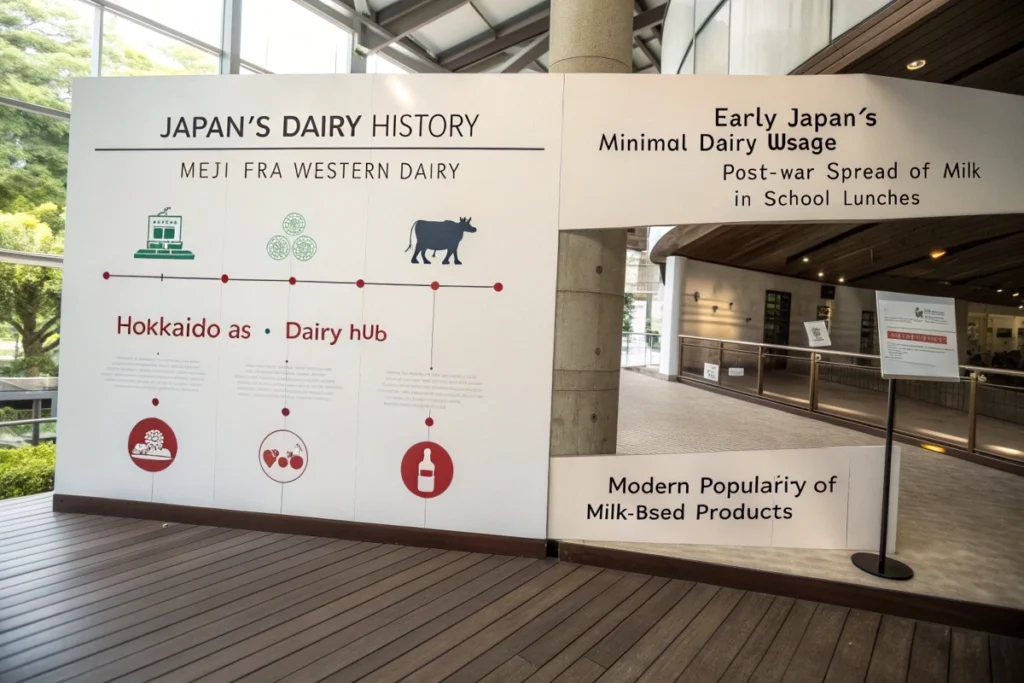
Practical Examples/Use Cases
Scenario 1: Shokupan Lunchbox
A busy parent decides to prepare a quick lunch for their child using Shokupan. They cut the crusts off the fluffy milk bread to craft a classic Japanese sandwich with egg salad. The child opens the lunchbox at school to find soft, milky bread that complements the creamy filling. The combination is comforting and kid-friendly, showcasing how japanese foods that use milk seamlessly blend into daily life.
Scenario 2: Milky Hot Pot Night
On a chilly evening, a group of friends gathers for a “milky hot pot.” The broth is made by adding a cup of Hokkaido milk to a base of miso and dashi. Vegetables, sliced chicken, and udon noodles simmer until tender. The final touch—more milk or a dash of cream to thicken the broth. Each bite is warming and slightly sweet, a perfect contrast to the cold weather outside.
Scenario 3: Hokkaido-Style Café Visit
While traveling in Tokyo, a tourist stumbles upon a small café advertising “Hokkaido Milk Soft Serve.” Intrigued, they order a cone. The texture is unbelievably smooth, and the flavor tastes pure, free of any artificial aftertaste. This sweet indulgence becomes a memorable highlight of the trip, sparking interest in milk-based Japanese sweets. Later, the tourist tries making a version of it at home, referencing a Japanese steak recipe for a full dinner-to-dessert culinary experiment.
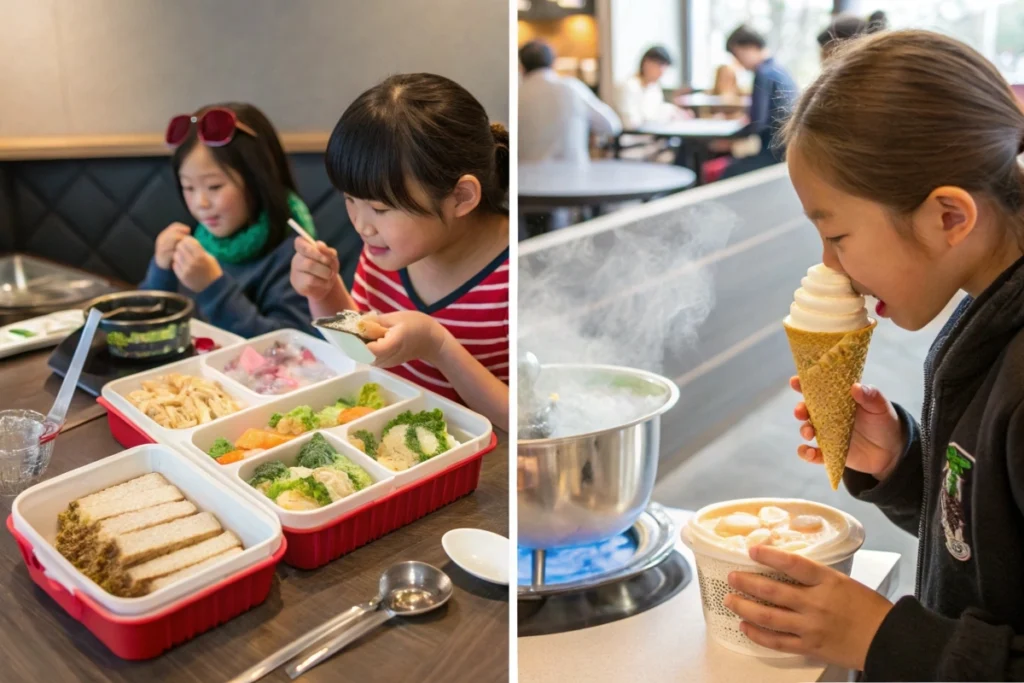
FAQs
Below are some frequently asked questions regarding japanese foods that use milk and related dairy products.
- Why is Hokkaido milk considered special?
Many credit Hokkaido’s cooler climate, spacious farmland, and stringent farming standards. The cows graze on nutrient-rich grass, leading to milk with higher butterfat content and natural sweetness. - How does Hokkaido milk vs normal milk compare in taste?
Hokkaido milk usually tastes creamier, with a richer mouthfeel. Some also detect a subtle, sweet undertone. Standard milk, especially mass-produced varieties, may be thinner and less flavorful by comparison. - What is Japanese milk bread?
Also called Shokupan, it’s a soft, fluffy white bread known for its slightly sweet taste and pillowy texture. Milk is a key ingredient, helping retain moisture and create that distinct melt-in-your-mouth crumb. - Where does Hokkaido milk come from?
As the name implies, it’s sourced primarily from dairy farms in Hokkaido, Japan’s northernmost island. The region’s fertile soil and cooler temperatures favor cattle farming, resulting in milk with a premium reputation. - Are there Japanese dishes that feature milk besides bread and desserts?
Yes. Some curries, soups, and hot pots incorporate milk for creaminess. Ramen shops occasionally add milk to create a smoother broth. It’s also common in certain baked goods and pastries. - What if I can’t find Hokkaido milk in my area?
While genuine Hokkaido milk might be challenging to locate outside Japan, high-quality whole milk can approximate a similar richness. Just look for dairy products with a higher fat percentage. Alternatively, you could check specialized Asian grocery stores or online retailers. - Is Japanese dairy more expensive?
Due to import costs and limited availability, Japanese dairy products—like Hokkaido milk—can be pricier abroad. Many enthusiasts find the taste worth the splurge, especially for special occasions or unique recipes.
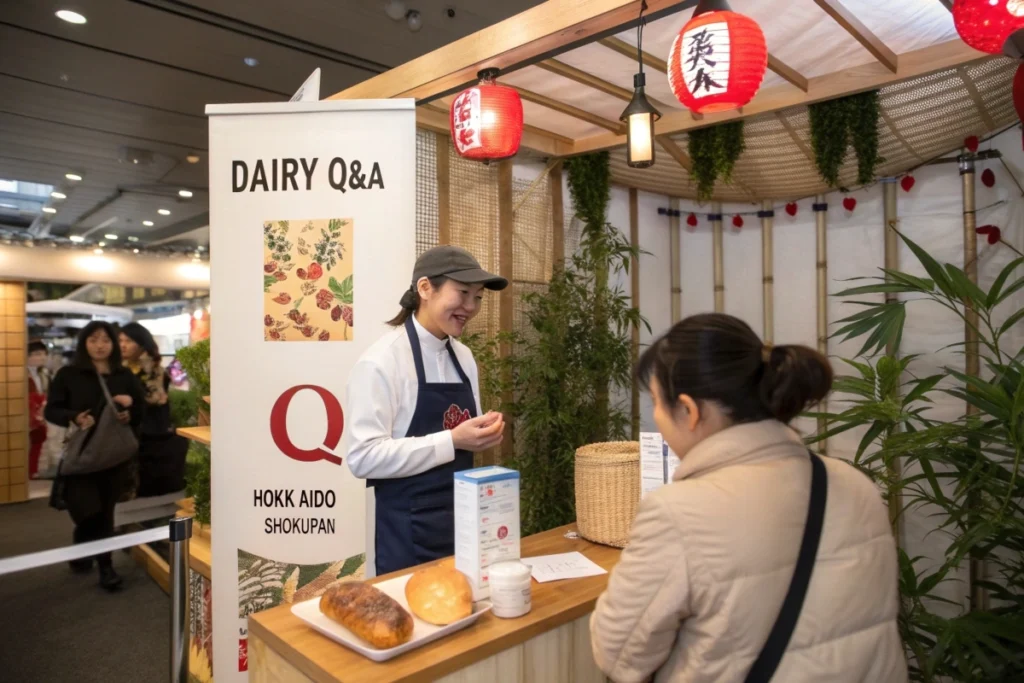
Conclusion
By now, you’ve journeyed through a world of japanese foods that use milk, exploring how dairy transforms everything from bread and desserts to savory curries. Hokkaido milk, famed for its creaminess, remains a standout ingredient that exemplifies Japan’s dedication to quality. Meanwhile, Shokupan’s fluffy texture has won hearts worldwide, proving that simple ingredients—like flour and milk—can yield extraordinary results.
Whether you’re intrigued by milky ramen broths or curious about dessert puddings, remember that Japanese culinary traditions continually evolve. The country’s embrace of dairy is a testament to its open-minded approach to cooking. Each new wave of inspiration results in dishes that merge global techniques with distinctly Japanese flavors.
Feeling ready to try a milk-based recipe at home? Start small, perhaps with a comforting milky hot pot or a loaf of Shokupan. As you gain confidence, consider pushing boundaries—why not add a splash of Hokkaido milk to your next homemade ice cream or sauce? If you need more ideas, check out a Japanese old-fashioned recipe or other dairy-friendly dishes on your culinary exploration. Embrace the creamy side of Japanese cuisine, and you might discover a whole new dimension to your favorite meals.
